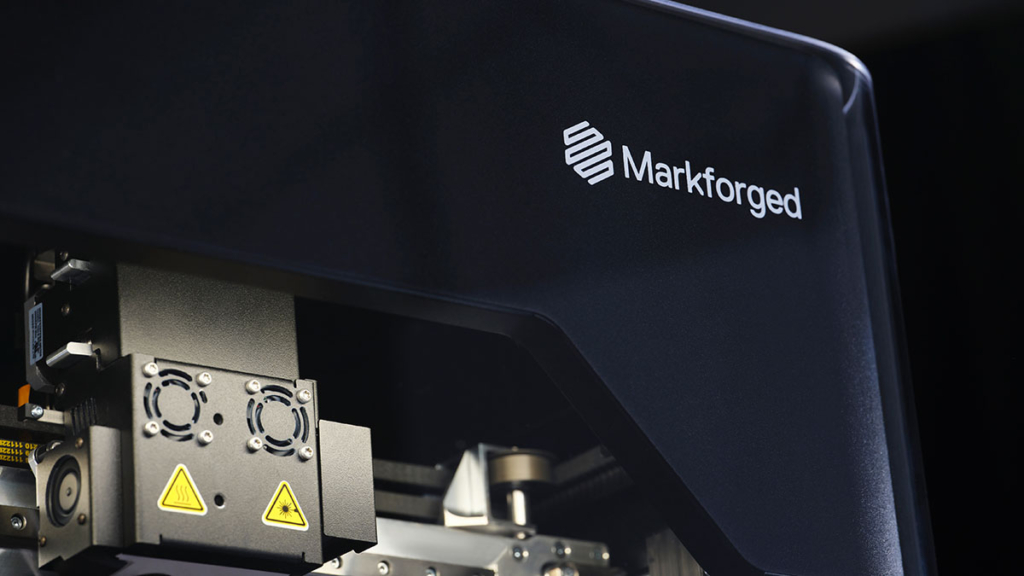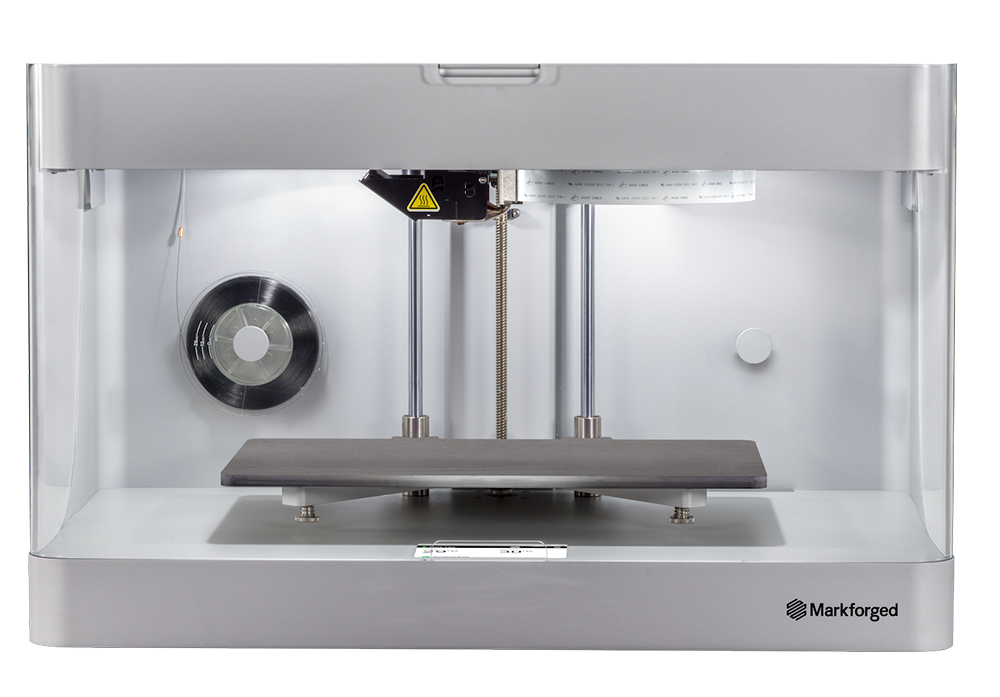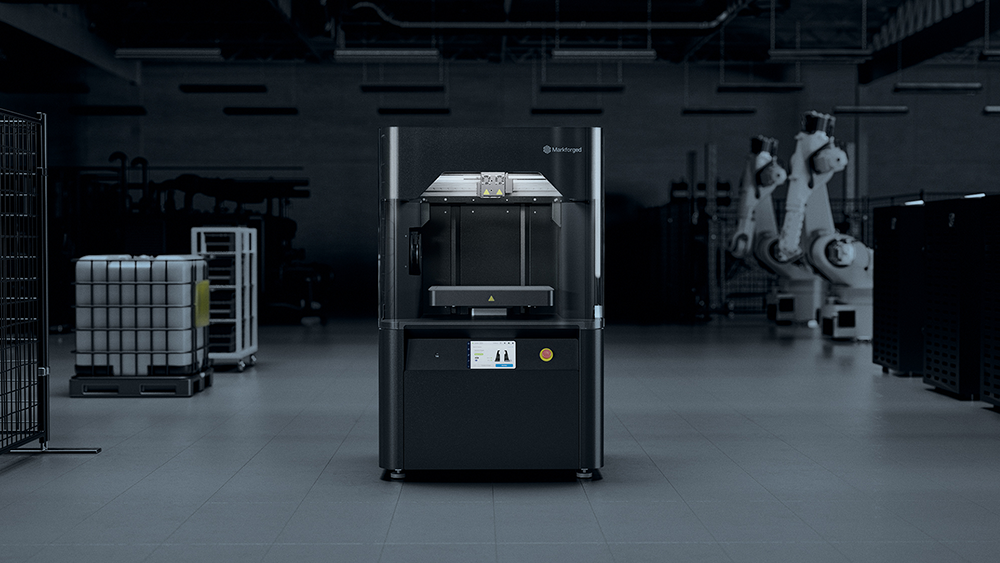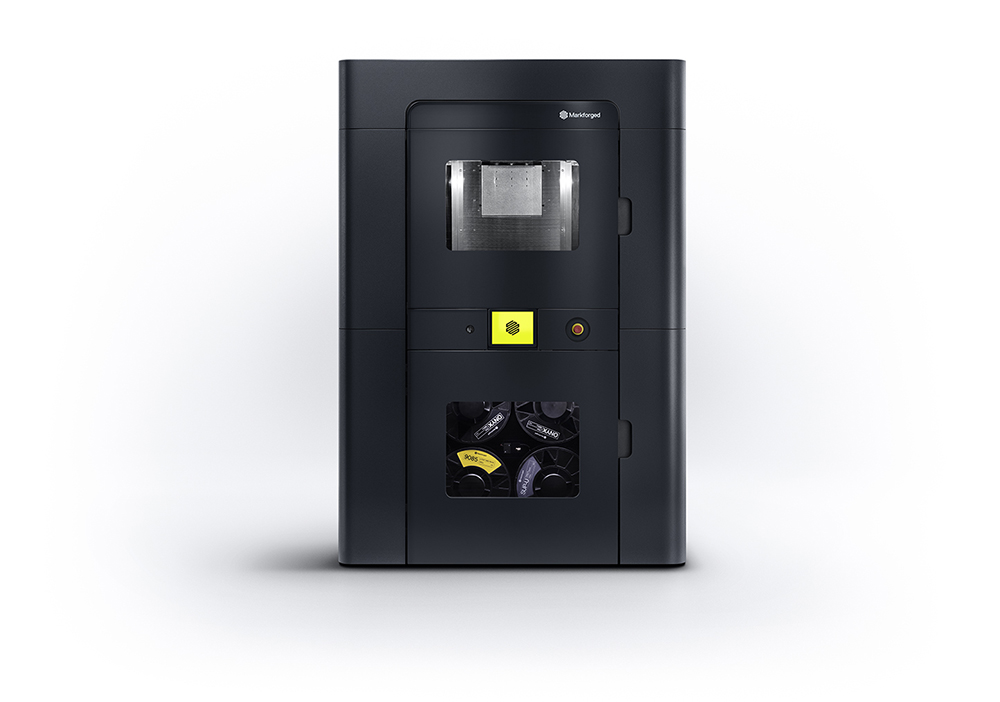Since entering the market in 2013, Markforged has pushed the industry forward with its fused filament fabrication (FFF) 3D printers. With multiple Markforged 3D printers on the market, here’s a breakdown of the Mark Two, Onyx Pro, X7, FX10 and FX20 so you can choose the right printer for your business needs.
What Are Markforged 3D Printers?
Markforged 3D printers are known for being reliable workhorses that produce extremely strong and durable parts ready for the most demanding applications.
These printers have the unique capability of embedding continuous fibers inside plastic parts through a process called continuous fiber reinforcement (CFR). This fiber reinforcement gives significant improvements to the mechanical properties of printed parts and, in some cases, exceeds the strength of 6061 aluminum with printed composites.
Due to their high-quality raw plastic materials, such as Onyx, these 3D printers produce some of the most impressive-looking FFF parts on the market. Their product portfolio of composite printing systems ranges from desktop systems like the Mark Two to full-blown large-format industrial systems like the FX20.
All Markforged printers can run on cloud-based build management software called Eiger, which includes many features, such as printer maintenance tracking, part strength simulation, role-based access control, user management, custom analytics and job history tracking. Markforged offers both online and offline software to meet the most stringent security needs. The online version is included with the printers, but the offline version is a paid add-on.
These benefits and features make Markforged printers an ideal option for both large and small organizations with single or multiple locations all over the world.
Mark Two & Onyx Pro: Versatile Desktop Printers
Printing Capabilities:
- Incredible continuous fiber strength in a small package
- Equipped with removable kinematic build bed
Materials:
- Plastics
- Onyx (carbon fiber nylon) (Onyx Pro & Mark Two)
- Nylon White (Mark Two)
- Polylactic acid (PLA) (Onyx Pro & Mark Two)
- Thermoplastic polyurethane (TPU) 95A (Onyx Pro & Mark Two)
- Fiber
- Fiberglass (Onyx Pro & Mark Two)
- Carbon fiber (Mark Two)
- Kevlar (specialized continuous Aramid fiber) (Mark Two)
- High Strength, High Temperature (HSHT) fiberglass (Mark Two)
Build Volume: 320 mm x 132 mm x 154 mm (12.6 in x 5.2 in x 6.0 in)
Dimensions: 584 mm x 330 mm x 355 mm (23 in x 13 in x 14 in)
Layer Heights: 100 microns (µm) to 200 microns (µm)
Software: Eiger (included with printer)
Ideal for:
- Beginners
- Startups
- Small businesses
Mark Two and Onyx Pro are versatile desktop printing systems that can print with both plastics and continuous fibers. They are excellent introductory 3D printers for those looking to enter the additive manufacturing world.
Each system is very compact and easy to set up to hit the ground running once the system has been unboxed. Power requirements are minimal as the machines are powered by a standard 110V AC outlet.
These systems boast a build volume of 320 mm x 132 mm x 154 mm (12.6 in x 5.2 in x 6.0 in), and both machines weigh 35 lbs. with footprints of 584 mm x 330 mm x 355 mm (23 in x 13 in x 14 in).
Plastics available for print on the systems include the most popular Markforged material called Onyx (carbon fiber nylon), as well as Nylon White (Mark Two only), polylactic acid (PLA) and thermoplastic polyurethane (TPU) 95A.
The only available fiber for the Onyx Pro is fiberglass. The Mark Two has additional fibers, including carbon fiber, Kevlar (specialized continuous Aramid fiber) and High Strength, High Temperature (HSHT).
Mark Two and the Onyx Pro can print at layer heights ranging from 100 to 200 microns, printing parts that are true to your CAD designs. The Mark Two has a removable kinematic build bed.
X7: The Flagship Industrial 3D Printer
Printing Capabilities:
- Large build volume for large, printed parts or more printed parts placed in a single build
- Equipped with removable kinematic build bed
- 2X faster print speed than smaller printers
- In-process part inspection like automated QA inspection
- Laser bed leveling
Materials:
- Plastics
- Onyx (carbon fiber nylon)
- Nylon White
- Polylactic acid (PLA)
- Thermoplastic polyurethane (TPU) 95A
- Fiber
- Fiberglass
- Carbon fiber
- Kevlar (specialized continuous Aramid fiber)
- High Strength, High Temperature (HSHT) fiberglass
- Electrostatic Dissipative
- Flame Retardant
Build Volume: 330 mm x 270 mm x 200 mm (13.0 in x 10.6 in x 7.9 in)
Dimensions: 584 mm x 483 mm x 914 mm (23 in x 19 in x 36 in)
Layer Heights: 50 microns (µm) to 250 microns (µm)
Software: Eiger (included with printer)
Ideal for:
- Intermediate professionals
- Startups
- Small businesses
The X7 is the flagship industrial system out of the Markforged printer lineup. It’s a well-tested workhorse and a nice improvement over the Mark Two.
With a build volume of 330 mm x 270 mm x 200 mm (13.0 in x 10.6 in x 7.9 in), the X7 has a much larger build platform than the Mark Two. This extra build envelope allows for larger printed parts or more printed parts placed in a single build.
The X7 weighs 106 lbs. and has a footprint of 584 mm x 483 mm x 914 mm (23 in x 19 in x 36 in). Compared to the Mark Two, it has more layer height options, ranging from 50 microns to 250 microns. The 250-micron layer height option significantly improves max print speed, making the system about two times faster for those who need their parts quicker.
It also has additional tech baked into the platform, such as laser bed leveling, in-process part inspection and a camera to monitor builds through the Eiger software. These hi-tech options continue to streamline the print workflow and provide automated QA inspection built right into the machine so you can check it as it prints. The X7, like the Mark Two, also has a removable kinematic build bed that is magnetically connected to the printer.
As for printing materials, it has the same plastic and continuous fiber material options as the Mark Two, with the addition of Onyx ESD (electrostatic dissipative), Onyx FR (Flame Retardant) and carbon fiber FR.
The X7 also has access to aerospace variants of materials including Onyx FR and carbon fiber materials, providing lot-traceability. The system features a material cabinet underneath the printer, which stores a dry box for holding the actively loaded filament.
FX10: Next Gen Industrial Composite 3D Printer
Printing Capabilities:
- Most advanced tech features & sensor capabilities than other printers
- 4X faster print speed than smaller printers
- Equipped with a precision-ground aluminum vacuum bed
- Heated build chamber up to 60°C
- Humidity-controlled material drawer that handles up to four spools
- Automatic spool changeover and fast spool loading capabilities
- In-process part inspection like automated QA inspection
- Laser automated bed leveling
Materials:
- Plastics
- Onyx (carbon fiber nylon)
- Fiber
Build Volume: 375 mm x 300 mm x 300 mm (14.8 in x 11.8 in x 11.8 in)
Dimensions: 760 mm x 640 mm x 1,200 mm (30 in x 25 in x 46 in)
Layer Heights: 125 microns (µm) to 250 microns (µm)
Software: Eiger (included with printer)
Ideal for:
- Intermediate and expert professionals
- Small and midsize businesses
The FX10 is the new generation industrial composite printer in the Markforged lineup. It has the most advanced tech features and sensor capabilities of all the Markforged printers. Enhanced automation and print speed make the FX10 a great industrial printer.
With a build volume of 375 mm x 300 mm x 300 mm (14.8 in x 11.8 in x 11.8 in), the FX10 has the build size to tackle a wide array of print applications. It weighs 240 lbs. and has a footprint of 760 mm x 640 mm x 1,200 mm (30 in x 25 in x 4y6 in). It also has a layer height ranging from 125 microns to 250 microns.
This system showcases a heated build chamber up to 60°C and a max print speed approximately four times faster than the Mark Two.
The FX10 departs from the kinematic build plate found in the Mark Two and the X7 by using a precision-ground aluminum vacuum bed, which distributes the heat more evenly. With this system, bed leveling is also completely automated.
It also incorporates a humidity-controlled material drawer that can handle up to four spools of material. Because it can hold several spools, this drawer allows for an automatic spool changeover, enabling the system to quickly load a new spool when the previous one runs out.
Like the X7, the FX10 incorporates a laser micrometer for in-process part inspection, allowing you to monitor the build as it prints. The FX10 runs off of a 110V 12A power outlet.
Onyx and carbon fiber materials are currently available for this machine. More material options are coming.
FX20: Large Format, Composite 3D Printer
Printing Capabilities:
- 4X faster print speed than smaller printers
- Equipped with a precision-ground aluminum vacuum bed
- 84L heated build chamber
- Heated build chamber up to 200°C
- Humidity-controlled material drawer that handles up to four spools
- Automatic spool changeover and fast spool loading capabilities
- Laser automated bed leveling
Materials:
- Plastics
- Onyx (carbon fiber nylon)
- Vega (high-temperature plastic)
- ULTEM™ 9085 filament
- Fiber
- Fiberglass
- Carbon fiber
- High-temperature carbon fiber
- Kevlar (specialized continuous Aramid fiber)
- Electrostatic Dissipative
- Flame Retardant
Build Volume: 525 mm x 400 mm x 400 mm (20.7 in x 15.7 in x 15.7 in)
Dimensions: 1,325 mm x 900 mm x 1925 mm (52 in x 36 in x 76 in)
Layer Heights: 50 microns (µm) to 250 microns (µm)
Software: Eiger (included with printer)
Ideal for:
- Intermediate and expert professionals
- Midsize to large businesses
- Businesses working with robust materials like aerospace products
The FX20 is the largest composite 3D printer in the Markforged product portfolio. It’s great for printing large functional parts or applications demanding the most robust printed materials.
The FX20 boasts a build volume of 525 mm x 400 mm x 400 mm (20.7 in x 15.7 in x 15.7 in). It weighs 1,170 lbs. and has a footprint of 1,325 mm x 900 mm x 1,925 mm (52 in x 36 in x 76 in).
This 3D printer can use the toughest Markforged materials, such as ULTEM™ 9085 filament and Markforged’s Vega, a micro carbon fiber-filled polyether ketone ketone (PEKK) material. These two plastics have higher strengths and heat deflection temperatures than the other Markforged materials and are ideal for aerospace and defense products like aircraft handles and knobs, aircraft interior paneling and custom ducting.
It can also print additional plastics from the Markforged portfolio, such as Onyx reinforced with continuous carbon fiber.
The FX20 has access to larger 3200CC spools of material instead of the standard 800CC spools, making it great for longer prints. This system also has auto spool changeover, allowing for loading spools quickly. It holds two active XL spools and stores two more in its moisture-controlled material drawer.
It has a similar bed configuration to the FX10, including automated bed leveling. The FX20 has an 84L heated build chamber that can reach 200°C. Its print speed is roughly four times faster than that of the Mark Two.
The FX20 has a higher power requirement than the other Markforged printers, with a 240V 3-phase specification.
How to Determine Which 3D Printer Is Right for You?
With so many impressive Markforged 3D printers on the market, finding the ideal printer for your projects can be challenging. Researching and jotting down specs is the first step.
The next steps are determining your specific needs, such as your part size range, your ongoing part production needs, the material type, part use cases, and your budget. Let’s explore what that means for you.
Identify the Part Sizes You Need & How Many
Your average part size and expected quantity of needed parts are two of the most important factors for determining which system is best for your additive manufacturing lab.
Start by asking yourself:
- How small or large are my prints? Or is it a combination of small and large?
- How many of my projects have small-part prints vs. large-part prints?
- Can you get by printing large parts into smaller pieces?
- How many parts do I need to print?
- How quickly do I need to print these parts?
When choosing your printer, it’s better to err on the side of selecting a system with a slightly larger build volume rather than the other way around. If you don’t need to print a lot of large parts, you might be able to get by splitting large parts into smaller pieces on a case-by-case basis. But if you need to print a lot of large parts, you’ll benefit from a larger build volume later.
If you need to print many parts, it’s best to look into 3D printers with faster print speeds so you can print them quickly. You can also simply purchase multiple smaller 3D printers to create a print farm to handle higher quantities of parts, but it can depend on your budget and the 3D printer’s specs, like overall machine dimensions, material it can handle, number of spools it can hold and the power the printer draws.
The Mark Two, Onyx Pro and X7 would be good candidates to explore for print farms. For large build sizes and print speeds, the FX10 and FX20 will be the best performers.
Define Your Material Type & Application Requirements for Your Parts
Material type and application requirements can also determine which printing system is best for you.
Clearly define what your printed parts will need and require from an application perspective. This can help you identify the type of material you will need. If you’re unsure which fiber to use for your application, read our quick fiber selection guide to help you find the right one.
Below are a few items to consider when thinking about application requirements:
- Accuracy Requirements
- Flame Retardant (UL-94) Requirements
- Temperature Requirements
- Electrostatic Dissipative Requirements
- Strength Requirements
- Lot-Traceability Requirements
If some of these items are important, you’ll want to look into the X7, FX10 and FX20 printers, which have the best available materials, accuracy performance and features.
If you don’t need those items, you may look into the smaller Markforged 3D printers like the Mark Two and Onyx Pro, which work with continuous carbon fiber, polylactic acid (PLA), thermoplastic polyurethane (TPU) 95A, nylon and fiberglass.
Establish Your Budget
Budget is often the critical determining factor in choosing a 3D printer.
As you define your budget, start with an ROI analysis to identify how much value a particular 3D printer will bring to your organization. Knowing how long it will take for additive equipment to pay for itself is key in making a smart, strategic decision for your business.
In addition, looking at your current and future needs can help you decide which printer best accommodates your growing business.
If you need assistance purchasing your printer, financing options are also very common when purchasing additive equipment. Affordability is one of the common misconceptions about 3D printing and adopting additive manufacturing in your organization.
Contact us for detailed pricing information, and our dedicated sales experts can help walk you through different options.
Comparing 5 Markforged 3D Printers — Mark Two, Onyx Pro, X7, FX10 and FX20
The tables below provide quick snapshots of specific features and capabilities of five Markforged 3D printers to help you choose the best one for your business needs. Depending on your projects and goals, you may need to get more than one type of 3D printer.
3D Printer Hardware Comparisons
| Mark Two / Onyx Pro | X7 | FX10 | FX20 | |
| Build Volume | 320 mm x 132 mm x 154 mm, 6.5 Liters (12.6 in x 5.2 in x 6.0 in) | 330 mm x 270 mm x 200 mm, 17.8 Liters (13.0 in x 10.6 in x 7.9 in) | 375 mm x 300 mm x 300 mm, 33.8 Liters (14.8 in x 11.8 in x 11.8 in) | 525 mm x 400 mm x 400 mm, 84 Liters (20.7 in x 15.7 in x 15.7 in) |
| Print Bed | Kinematic Coupling | Kinematic Coupling | Precision Ground Aluminum Vacuum Bed | Precision Ground Aluminum Vacuum Bed |
| Z Resolution Range | 100 – 200 μm | 50 – 250 μm | 125 – 250 μm | 50 – 250 μm |
| Build Chamber | Not Heated | Not Heated | Heated up to 60°C | Heated up to 200°C |
| Material Storage | Outboard Dry Box | Inboard Dry Box | Humidity-Controlled Drawer (up to 4 spools) | Humidity-Controlled Drawer (up to 4 spools) |
| Power | 100-240 VAC, 150W (2A peak) | 100-240 VAC, 150W (2A peak) | 100-120 VAC, 12A or 200-240 VAC, 6A | 200-240VAC 3P+E, 24A or 347-416VAC 3P+N+E, 14A; 8 kW |
| Weight | 16 kg (35 lbs.) | 48 kg (106 lbs.) | 109 kg (240 lbs.) | 530 kg (1,170 lbs.) |
| Footprint | 584 mm x 330 mm x 355 mm (23 in x 13 in x 14 in) | 584 mm x 483 mm x 914 mm (23 in x 19 in x 36 in) | 760 mm x 640 mm x 1,200 mm (30 in x 25 in x 46 in) | 1,325 mm x 900 mm x 1,925 mm (52 in x 36 in x 76 in) |
Advanced Feature Comparisons
| Onyx Pro | Mark Two | X7 | FX10 | FX20 | |
| Out-of-Plastic Detection | ✔ | ✔ | ✔ | ✔ | ✔ |
| Out-of-Fiber Detection | ✔ | ✔ | ✔ | ||
| Fiber Jam Detection | ✔ | ✔ | ✔ | ✔ | ✔ |
| Adaptive Bed Levelling | ✔ | ✔ | ✔ | ||
| Automated Bed Leveling | ✔ | ✔ | |||
| Micron Precision Linear Encoders | ✔ | ||||
| Max Speed | 1x | 1x | 2x | 4x | 4x |
| Inspection (Compatible) | ✔ | ✔ |
Plastic Material Comparisons
| Onyx Pro | Mark Two | X7 | FX10 | FX20 | |
| Onyx™ | ✔ | ✔ | ✔ | ✔ | ✔ |
| Onyx ESD™ | ✔ | ✔ | |||
| Onyx FR™ | ✔ | ✔ | |||
| Nylon | ✔ | ✔ | |||
| Precise PLA | ✔ | ✔ | ✔ | ||
| Smooth TPU 95A | ✔ | ✔ | ✔ | ||
| ULTEM™ 9085 Filament | ✔ | ||||
| Vega™ | ✔ |
Continuous Fiber Material Comparisons
| Onyx Pro | Mark Two | X7 | FX10 | FX20 | |
| Fiberglass | ✔ | ✔ | ✔ | ✔ | |
| Carbon Fiber | ✔ | ✔ | ✔ | ✔ | |
| Carbon Fiber FR | ✔ | ✔ | |||
| High Temp Carbon Fiber | ✔ | ||||
| HSHT Fiberglass | ✔ | ✔ | |||
| Aramid Fiber (Kevlar) | ✔ | ✔ | ✔ |
The Final Note
The Markforged line of composite FFF 3D printers can tackle a wide range of applications, from jigs and fixtures to end-use enclosures, covers and brackets.
Understanding your current needs and predicting future ones is key to making the right printer choice. Your specific application requirements, preferred level of automation and production expectations will quickly help define which route to take for your business.
At Hawk Ridge Systems, we have a team of dedicated engineers and sales professionals eager to assist you when you’re ready for additional guidance. To learn more about Markforged 3D printers, contact us today!








